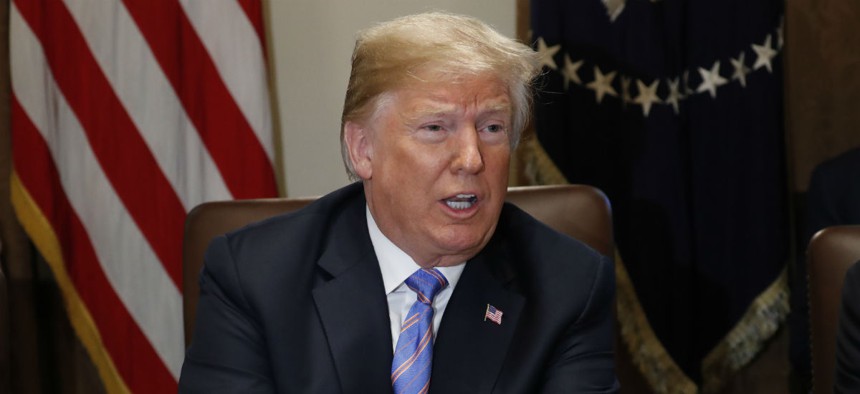
Pablo Martinez Monsivais/AP
Article Casts Doubt on the Legality of Trump's Administrative Law Judge EO
The move to give agencies greater latitude as they hire ALJs could be challenged under the Civil Service Reform Act, and agency implementation will need to follow the Administrative Procedures Act.
An attorney with the Congressional Research Service wrote Wednesday that court precedent and the Administrative Procedures Act may significantly limit the Trump administration’s legal authority as it implements the recent executive order removing administrative law judges from the competitive hiring process.
In an article in CRS’ Legal Sidebar series, legislative attorney Valerie Brannon wrote that there is a complex series of legal precedents governing executive orders that seek to change rules and regulations. Although the president is generally exempt from the Administrative Procedures Act, which prescribes a rulemaking process that requires advanced notice and a period for public comment before a rule can be enacted, the agencies tasked with implementing executive orders are not.
“These rulemaking procedures apply only to an ‘agency process,’” Brannon wrote. “The APA defines ‘agency’ to include ‘each authority of the government of the United States,’ but excludes Congress and the courts . . . [In Franklin v. Massachussetts, the Supreme Court] acknowledged that the APA definition of ‘agency’ does not expressly exclude the president, but noted that the president is not ‘explicitly included,’ either.”
Earlier this month, President Trump issued an executive order that would allow agency heads to pick whomever they wish to be administrative law judges, provided they are active lawyers or judges. Previously, the Office of Personnel Management would independently vet candidates, and then submit to agencies a short list of potential names.
Although the APA may not restrict Trump’s ability to change the hiring process for ALJs, the Civil Service Reform Act might. Brannon suggested that efforts to halt the executive order in court “would likely depend on the nature of the suit and the particular statutory provision invoked.”
“The statute invoked in [the executive order] provides that the president may create ‘necessary exceptions of positions from the competitive service,’ as ‘conditions of good administration’ may warrant,” she wrote. “This language places substantive limitations on the president’s authority: he may only create exceptions so long as they are ‘necessary’ and warranted by ‘conditions of good administration.’”
White House officials have argued that the Supreme Court’s recent decision in Lucia. v. Securities and Exchange Commission requires the administration to change the hiring process for ALJs to avoid legal challenges. But union representatives and observers dispute that, suggesting that the decision may not have any impact for the vast majority of the 1,900 ALJs employed by federal agencies.
While the president likely did not need to abide by APA rulemaking procedures in issuing the executive order, agencies will have to heed the law going forward.
Although the APA does not restrict the president from ordering changes to federal rules and regulations, it does govern how agencies work to implement those orders. In the case of the recently issued executive order moving the hiring of administrative law judges from the competitive to the excepted service, OPM would be required to follow rulemaking procedures required by the APA.
“It appears that the U.S. Office of Personnel Management will primarily be implementing the directive—the executive order directs OPM to adopt regulations and provide guidance as necessary to implement the order, and OPM has already issued a guidance memo ‘to address several issues that may arise as agencies’ begin to implement the order,” Brannon wrote. “[If] OPM does act to amend existing rules, federal law expressly requires the agency to follow APA’s rulemaking procedures.”







